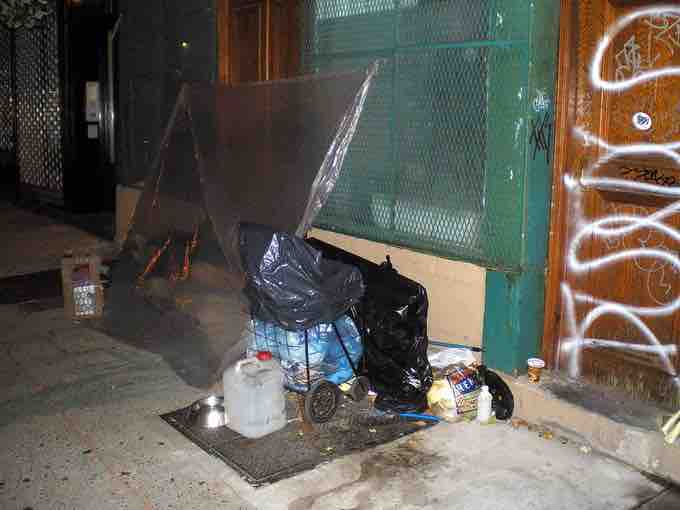Homeless people are those who lack a regular, adequate residence. Although homeless people stereotypically live on the streets, many may spend some nights in shelters, transitional housing, or cars and makeshift dwellings.
Homelessness is a social problem, due in large part to structural inequality and the maldistribution of resources. However, individual risk factors help explain why certain individuals become homeless instead of others . Those at a higher risk of becoming homeless include veterans, people suffering from substance abuse or mental disorders, and the unemployed.
Risk Factors
Many veterans return from war with insufficient training to successfully navigate the job market or with skills that are not in demand in the civilian world. They may also suffer from chronic physical or psychological conditions sustained in combat that make regular employment difficult. The federal government provides services to help veterans transition to civilian life, but some still struggle and, unable to find a job or to reintegrate, end up homeless.
Individuals with substance abuse problems and mental disorders represent a large number of the homeless. In the United States, 22 percent of the homeless have serious mental illnesses or are physically disabled, and 30 percent have substance abuse problems. Popular perception often blames the victim, suggesting these individuals are at fault for becoming homeless. However, this perspective denies structural elements that contribute to both homelessness and substance abuse.
Although most homeless people are single men, in tough economic times, families are at increased risk of homelessness due to unemployment. When unemployment rates increase, homelessness tends to increase, too. When markets crash, even families that appeared to be middle class may suddenly become homeless. In the United States, 23 percent of homeless people are families with children—the fastest growing segment of the homeless, due largely to the economic collapse in 2008.
Social Causes
Economic downturns are one of many social factors that cause homelessness. Urbanization itself may contribute to the problem. Cities must sustain a large population in a small area, which puts pressure on resources . In the United States, 71 percent of the homeless reside in urban areas.

Street Dwellers in Mumbai
On the outskirts of large developing cities, it may be a fine line between living in a slum or as a homeless person, as neither group generally possesses legal rights to land or a permanent dwelling.
Homeless people who suffer from substance abuse or mental illness often lack access to effective treatment options, a condition exacerbated by deinstitutionalization in the 1960s and 1970s. Prior to the 1960s, individuals with mental illness were frequently committed to long-term institutions, but deinstitutionalization closed these institutions in favor of community-based treatment. Unfortunately, many people released from these institutions had no place to go and wound up homeless.
Family support can provide a buffer against homelessness; those who lack support are at increased risk. Over half of children who "age out" of social systems such as foster care find themselves homeless. Social stigma also contributes to homelessness. Teenagers who become homeless have often run away from home or been thrown out by their parents, frequently because of their sexual orientation. A 2010 study by the Center for American Progress revealed that 20 to 40 percent of homeless youth identify as LGBT.
Solutions
Given its diverse and deeply entrenched causes, homelessness is hard to address. In the past, some purported solutions have been more attentive to the desires of privileged members of society than to the homeless; they have reinforced stigma and criminalized vagrancy in an attempt to sweep the problem under the rug. Rather than stigmatizing or criminalizing homeless individuals, a long-term approach to combat homelessness must focus on meeting the needs of the homeless. The most promising solutions are holistic approaches that combine housing, health care, and education, but such programs are limited. Instead, a policy patchwork provides some housing, some healthcare, and some education, but not a comprehensive plan.
Nonprofit and government programs exist to provide affordable housing, but face funding problems and a history of failure. In the mid-twentieth century, the government attempted to solve the housing crisis by creating massive housing projects with low rents to support the needs of low-income families, but facilities were decrepit, had little security, and eventually became havens for crime—perpetuating, rather than solving, many of the problems faced by low-income individuals. Many of these projects have been destroyed and government housing authorities have focused more on creating mixed-income affordable housing.
Given the large percentage of homeless who suffer from illness, adequate health care is an essential component to ensuring that people stay off of the streets. But in the United States, most people get health insurance through employers, leaving the unemployed with inadequate access to healthcare. Medicaid was established to provide healthcare to the indigent, but Medicaid lacks funding to adequately meet homeless needs.
Education can provide homeless children a way out, but practical barriers, such as residency restrictions, medical record verification, and transportation issues, often keep homeless youth out of school. The McKinney-Vento Act attempts to overcome these barriers by mandating equal opportunity for a free public education for homeless students.

Homeless Seek Shelter
People who are homeless are often forced to sleep under makeshift shelters that offer little protection from the elements and no security.